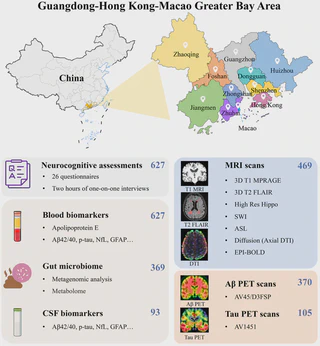Pathophysiology characterization of Alzheimer’s disease in South China’s Aging Population: for the Greater-Bay-Area Healthy Aging Brain Study (GHABS)

INTRODUCTION: The Guangdong-Hong Kong-Macao Greater-Bay-Area of South China has an 86 million population and faces a significant challenge of Alzheimer’s disease (AD). However, the characteristics and prevalence of AD in this area are still unclear due to the rarely available community-based neuroimaging AD cohort.
METHODS: Following the standard protocols of the Alzheimer’s Disease Neuroimaging Initiative, the Greater-Bay-Area Healthy Aging Brain Study (GHABS) was initiated in 2021. GHABS participants completed clinical assessments, plasma biomarkers, genotyping, magnetic resonance imaging (MRI), β-amyloid (Aβ) positron emission tomography (PET) imaging, and tau PET imaging. The GHABS cohort focuses on pathophysiology characterization and early AD detection in the Guangdong-Hong Kong-Macao Greater Bay Area. In this study, we analyzed plasma Aβ42/Aβ40 (A), p-Tau181 (T), neurofilament light, and GFAP by Simoa in 470 Chinese older adults, and 301, 195, and 70 had MRI, Aβ PET, and tau PET, respectively. Plasma biomarkers, Aβ PET, tau PET, hippocampal volume, and temporal-metaROI cortical thickness were compared between normal control (NC), subjective cognitive decline (SCD), mild cognitive impairment (MCI), and dementia groups, controlling for age, sex, and APOE-ε4. The prevalence of plasma A/T profiles and Aβ PET positivity were also determined in different diagnostic groups.
RESULTS: The aims, study design, data collection, and potential applications of GHABS are summarized. SCD individuals had significantly higher plasma p-Tau181 and plasma GFAP than the NC individuals. MCI and dementia patients showed more abnormal changes in all the plasma and neuroimaging biomarkers than NC and SCD individuals. The frequencies of plasma A+/T+ (NC; 5.9%, SCD: 8.2%, MCI: 25.3%, dementia: 64.9%) and Aβ PET positivity (NC: 25.6%, SCD: 22.5%, MCI: 47.7%, dementia: 89.3%) were reported.
DISCUSSION: The GHABS cohort may provide helpful guidance toward designing standard AD community cohorts in South China. This study, for the first time, reported the pathophysiology characterization of plasma biomarkers, Aβ PET, tau PET, hippocampal atrophy, and AD-signature cortical thinning, as well as the prevalence of Aβ PET positivity in the Guangdong-Hong Kong-Macao Greater Bay Area of China. These findings provide novel insights into understanding the characteristics of abnormal AD pathological changes in South China’s older population.